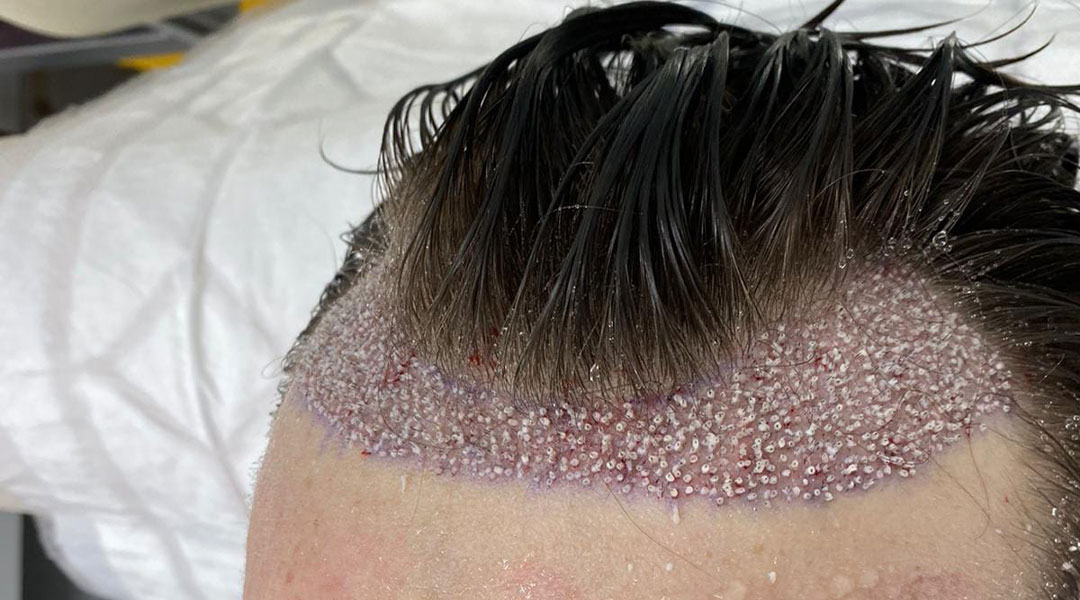FUE Transplant
A hair transplant is a procedure that involves surgically moving hair from a donor area, usually the back or sides of your head, to the recipient area where the hair loss occurred. There are many different benefits to having a hair transplant. These include but are not limited to:
- Natural looking results as the hair is your own hair transplanted
- Long-lasting results as the transplanted hair is natural and will continue to grow
- Can be combined with other treatments, including medication or scalp micropigmentation.
Follicular unit extraction, or an FUE transplant is a type of hair transplant that will involve extracting individual hair follicles from the donor area and transplanting them into the recipient area of the head.
FUE hair transplants will be better for people who have finer or curlier hair, as the tool used in this procedure is less likely to damage the hair follicles. It is also good for those who are seeking a procedure that is minimally invasive and has a quicker recovery time compared to other hair transplants.
As the FUE transplants use individual follicles one at a time, it will not leave a scar on your scalp, meaning that the donor area can be cropped or shaved, without any scarring appearing on the scalp. FUE can also be considered minimally invasive, as it does not require any incisions in the head, or stitches. This means that there will be less discomfort compared to the other methods of transplantation, as well as a quicker recovery time compared. FUE is used with individual follicles, meaning it can be used to treat many different types of hair loss, including male pattern baldness, female pattern baldness, scarring alopecia, etc.

FUT Transplant
An FUT Transplant is a type of hair transplant that involves removing hair strips at a time, rather than individual follicular units, and then transplanting them into the recipient area. The strips that are taken can differ in size, due to the many differences in bald spot and hair loss sizes, but the strips usually do not exceed 1/1.5 cm wide. Once the follicles are removed from the strip they will be re inserted into your scalp.
Who can have an FUT Procedure?
Men with male pattern baldness, or androgenic alopecia are generally the best candidates for FUT transplants, this is because the condition normally appears in a certain pattern or shaped hairline on the scalp/temple.
FUT is generally performed on people over the age of 25, usually because at a younger age the hair will still be growing and it is harder to predict hair loss patterns in younger people. FUT is also a good candidate for people with the “Norwood pattern” of hair loss on their scalp or temple, as the grafts of skin will fit better covering that type of hair loss. People who have a higher hair follicle density will generally receive better coverage from this transplantation.
Some benefits of the FUT hair transplants include the fact that a large number of grafts can be transplanted at one time, which is particularly beneficial to individuals that have extensive hair loss. FUT transplants can also be combined with other treatments for better results. FUT can also be used to address many different types of hair loss. FUT can be used to increase the density of the hair in different areas, such as the hair line or the crown to create a more balanced and natural looking appearance. FUT is generally less expensive that the other hair transplant procedures.
Overall Conclusion
Both follicular unit extraction (FUE) and follicular unit transplantation (FUT) are effective hair transplant techniques that can produce natural-looking results and offer a permanent solution to hair loss. However, there are some key differences between the two procedures that may make one more suitable for an individual than the other.
FUE involves extracting individual hair follicles from the donor area using a specialized punch tool and transplanting them to the recipient area. FUT involves removing a strip of skin from the donor area and dissecting it into individual follicular units, which are then transplanted to the recipient area.
One of the main differences between FUE and FUT is the method of extraction. FUE does not leave a linear scar, as the individual follicles are extracted one at a time, whereas FUT typically leaves a linear scar at the donor site due to the amount of hair that is transplanted. FUT allows for the transplantation of a larger number of grafts in a single session, which can be particularly beneficial for individuals with extensive hair loss. FUT is also generally less expensive than FUE.
Ultimately, the best option for you will depend on your individual needs and circumstances. It is important to consult with a qualified hair transplant surgeon to determine the most suitable treatment option for you.
If you feel like you are suffering from hair loss and are considering a hair transplant but don’t know which would be better for you, please feel free to book a consultation to discuss which would be better for you in your individual case here.

